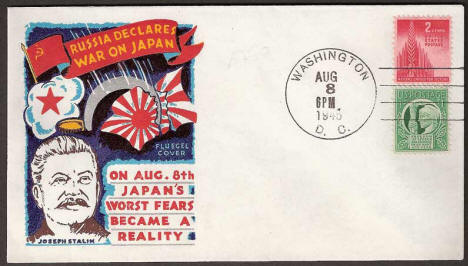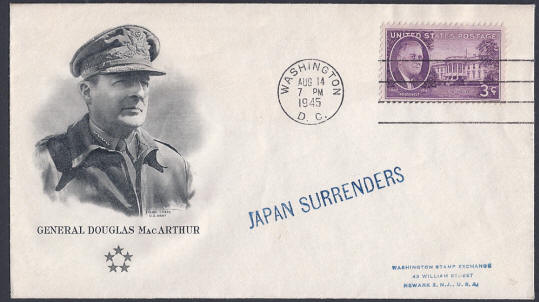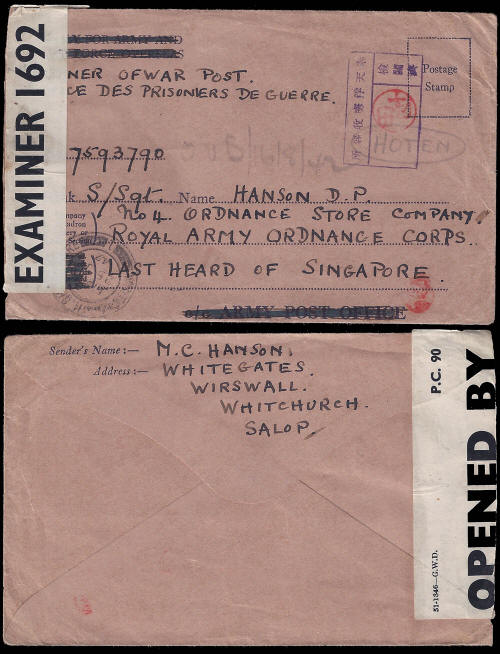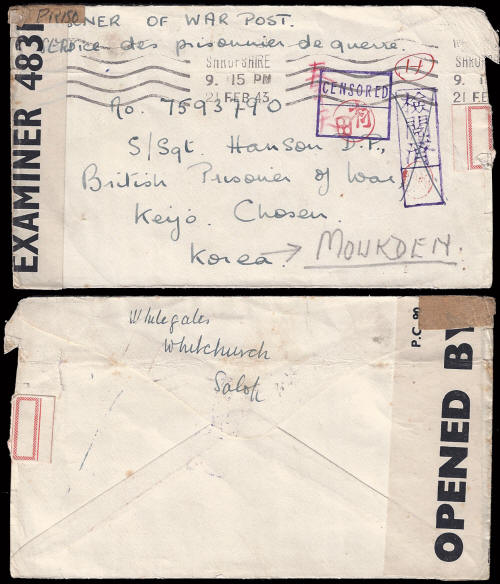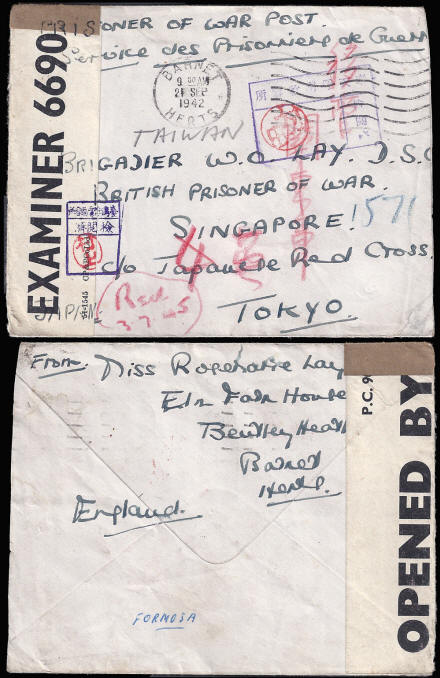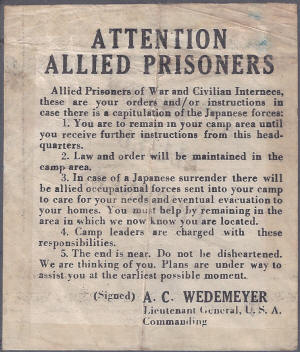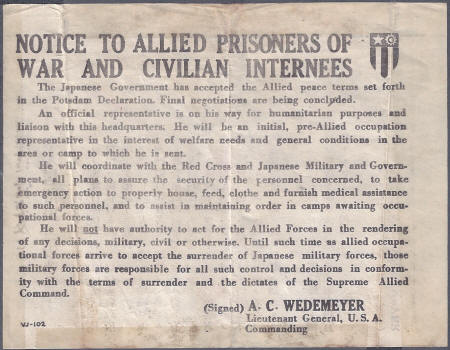 |
|||||
|
|
|
Prisoner of War Covers |
|||
|
Background During WWII or what the Japanese called the Greater East Asia War, Manchukuo played host to a number of prisoner of war camps. The focus of these camps was in the Western part of the city of Mukden, now Shenyang. Mukden was known as Hoten to the Japanese and the camps were controlled by the Kanto Army based in Dairen. The prisoners were mostly Americans transported is the famous "Hell Ship" Tottori Maru from Corregidor, many having survived the Bataan death march. These troops had been selected because they had some engineering experience and were put to work in the surrounding factories, essentially being used as slave labour. The initial intake consisted of 1400 Americans, 81 British, 16 Australians and 3 New Zealanders all of whom arrived in November 1942 (reports vary). The men were initially housed in an old Chinese Army Barracks which, being built partly underground, was damp, cold and very unhealthy for the malnourished prisoner workforce. This camp was at least 4km from the factory in which most prisoners were forced to work and the inmates were greatly weakened by the 8km they had to march to and from work each day. Conditions in the camp were harsh, the prisoners arrived in poor health and were subjected to brutal treatment, the bitterly cold Manchurian winter, poor diet and lack of medicine meant that by summer of 1943 a total of between 205 and 300 prisoners had died (reports vary). Such were the losses that in July 1943 the Japanese decided to move the prisoners to a newer two story facility closer to the industrial area. Life for those in Hoten POW camps was difficult enough, but worse was in store for some unlucky inmates. There is some evidence that a number of prisoners may have been subjected to germ warfare experimentation by Japanese Unit 731 based at Ping Fan. Under the guise of the Kwantung Army's anti-infection and water supply depot they conducted numerous fatal "tests" on Chinese victims. Sinister visits were made to the camp on several occasions where selected prisoners were given unspecified injections and subjected to odd treatments, not all survived. At the end of the war, fleas infected with Bubonic Plague are reported to have escaped from this unit killing many in local villages. To find out more about this read "Guests of the Emperor" by Linda Goetz Holmes, this incident is also mentioned in the memoirs of Pu Yi "From Emperor to Citizen". The camp was under the control of a Japanese Commander, Col. Matsuda. The colonel had no respect for the Geneva convention and prevented the prisoners from receiving most of the Red Cross parcels sent to the camp. He also severely limited the distribution of mail keeping the parcels and mail in store rooms. The camp received two Red Cross visits under very restricted circumstances which made it impossible for the inspectors to make a proper assessment of conditions. They were thus was unable to report on the brutality of the regime suffered by most prisoners. In late 1944, in addition to the main camp, a series of satellite camps opened housing a further 300 men. Camp 4 was sited nearly 100 miles from Mukden at Cheng Chia Tun now Shuangliao and later at Xi-an (camp 5) to the North of Liaoyuan. Here the food supplies and treatment of prisoners was of a higher standard, officer prisoners were not expected to work. An account of life at Camp 4 (Shuangliao) can be found in "The Hard Way Home" by William C. Braly. These senior officers and staff had to be moved from Taiwan as a result of American advances. Included among the officers were US General Jonathan Wainwright. Under Gen Douglas MacArthur, Gen Wainwright was responsible for resisting the Japanese invasion of the Philippines in his role as Supreme Commander South West Pacific Area. Another high profile prisoner was Britain's General A. E. Percival, the former commander of Singapore. |
|||||
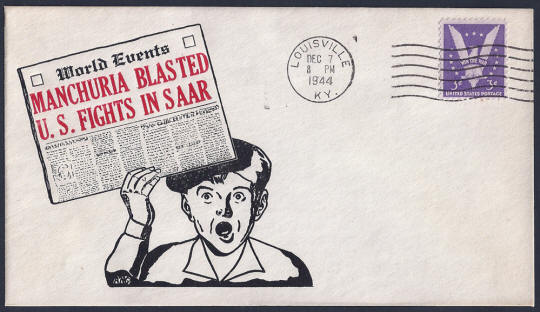 |
|||||
|
On 7th December 1944 an air raid
consisting of eighty-three B-29 Super fortress long range bombers
attacked Mukden. During the raid a stray bomb hit the main POW camp
in Mukden killing nineteen prisoners and wounding over fifty others. The aim of the raid was to destroy railway yards and many of the manufacturing plants making ammunition, machine tools, aircraft parts and military supplies. The timing was also significant, the 7th December 1944 being the third anniversary of the attack on Pearl Harbour. The above illustrated cover commemorates this raid. During the spring of 1945 food rations became very scarce and it was clear to the inmates that the Japanese were losing the war. Camp commanders had orders to kill prisoners if Japan fell. Stalin had agreed to wait three months from VE Day (8th May 1945) before launching an attack on China. True to his word on 8th August 1945 Russian attacked the Japanese forces in Manchuria. The August Storm offensive defeated the Japanese in twelve days driving them from Manchuria and ending the state of Manchukuo. The above illustrated cover commemorates the start of this campaign. On 14th August 1945 the surrender of Japan was made public. Even before the surrender had been announced America had sent a mission into Manchuria to liberate the camps and to free Gen Jonathan Wainwright, it was felt in Washington that US soldiers should not fall under the control of the Russian invasion forces. This parachute insertion of a four man team, plus an interpreter and a member of the Chinese Nationalist Army were able to negotiate the surrender of the camp ready for the repatriation of the prisoners. The Russian Red Army 6th Guards Tank Army occupied Mukden on 20th August and the first prisoners, all in need of medical attention left by air the following day. The American POW recovery team discovered storerooms containing Red Cross parcels and 1000's of items of mail withheld from the prisoners, some of the mail had been checked by the censor and had a censors mark, other mail had yet to be checked. This mail was made then available to surviving prisoners within the camp and sent on to those already evacuated. With regard to the value of these covers, mail from the camp, mostly in the form of postcards, is the most sought after and is very scare indeed due to the Japanese reluctance to allow any letters to be sent home. With regard to incoming covers, any British and ANZAC mail is very hard to find as this relates to only 10% of the prison population, American covers are most plentiful but these items should still be considered as rare and it goes without saying that the higher the rank the greater the value. Note: It is known that a smaller civilian internment camp existed at Anshan, this is poorly documented and housed mostly missionaries. You will have seen from other examples on this website that Manchukuo was home a large missionary community from America, England, Belgium, France and Germany. The Germans were seen as allies and were therefore not interned during the war. Very little mail has been seen sent to this camp and nothing sent from the camp is known to exist.
|
|||||
|
Prisoner of War Covers to Mukden Camp S/Sgt Douglas Hanson This cover is dated 25th July 1942 and addressed to a British P.O.W. "Last heard of in Singapore", it was eventually redirected to Mukden (Hoten) P.O.W. camp. The pencil marking OUS/16/8/42 indicates the date S/Sgt Douglas Hanson was sent overseas from the former place of capture, Singapore. He was one of 1000 British and A.I.F. sent with Japan "B" party to Korea (Chosen). He passed through camps is Japan and Korea before reaching Mukden on 9th November 1942, part of the initial intake, sailing from Japan on the Fukkai Maru. He spent the rest of the war working as slave labour for the Japanese until returning to England via Australia in 1945.The purple censor chop (size 23mm by 35mm) reads 検閲濟 Ken-etsu-zumi "Censored" (The last character is now written 済) and 奉天俘虜収容所 Hōten Furyo Shūyōjo Mukden POW Camp. The Han of the censor reads Murata 村田. Lt Murata was the assistant of Lt Miki Toru who was known for his cruelty to prisoners. This is a prisoner of war cover sent from England to Keijo (now Seoul) in Korea for Staff Sergeant Douglas Parker Hanson (1918-2002). By the time the cover arrived S/Sgt Hanson had been moved to Mukden in Manchukuo. The letter was censored and eventually received by him at Mukden. The letter has many postal markings, the postmark shows that it was posted in Shropshire in England on 21st February 1943, it was then opened and censored in England and re-sealed with tape reading OPENED BY EXAMINER 4831. The letter would then have been passed to the International Red Cross for delivery by airmail. There is a "crossed out" long boxed chop reading 検閲済 meaning Censored and including the small oval red censor's chop and above this a H in a circle applied by pen. The H stood for Hoten the Japanese name for Mukden and indicated that the prisoner has been moved to this camp. This is reinforced with a pencil marking MOUKDEN which is the French spelling. This re-direction would either have been made in Korea or Japan. To the left of this box is another box with the word CENSORED in English. This has been applied over a red pencil marking 奉天 reading Fengtian or Mukden. This indicates that the censor at Mukden camp also checked the letter and applied his own chop reading 村田 Murata. This letter was sent almost exactly a year before the liberation of S/Sgt Hanson, it must have lain un-censored and undelivered in a storeroom at Hoten POW camp for most of this time. One of the first things that happened after the liberation was the distribution of all withheld mails. This one document is a sad reminder of the Japanese failure to comply with the Geneva convention, unmarked as it is it speaks volumes about the care prisoners received while detained by the Japanese Army in Manchuria. Letters to, and a card from S/Sgt Douglas Hanson appear in The Postal History of the Prisoners of War and Civilian Internees In East Asia During the Second World War. Volume 6, Japan, Korea, Manchuria and Borneo 1942-1945 Hellships to Slavery by David Tett F.R.P.S.L. My thanks to Mr Graham Reynolds for supplying some of the background information concerning S/Sgt Hanson.
|
|||||
|
|
|||||
| Brigadier William Oswald Lay D.S.O. (1895-1953) | |||||
|
This cover was posted from Barnet on
21st September 1942 to Brig. W. O. Lay a prisoner of war
thought to be held in Singapore. The letter was sent c/o the
Japanese Red Cross in Tokyo from Herefordshire by the Brigadier's
daughter Rosemarie. There is an encircled note in red showing that
the letter was received on 3.7.45, over three years after posting. Brig. William Oswald Lay, DSO was in command of the 6th Indian Brigade consisting of 2 Battalion East Surrey Regiment, 1/8 Battalion Punjab Regiment and 2/16 Battalion Punjab Regiment when the British Army surrendered at Singapore. This cover has two purple censor chops, the first reads 検閲濟 Ken-etsu-zumi "Censored" (The last character is now written 済) and 奉天俘虜収容所 Hōten Furyo Shūyōjo Mukden POW Camp with the circular red Han reading Murata 村田. The second is very similar but smaller 15mm x 21mm box reading Taiwan Prisoner of War Camp - Censored. The oval red Han reads Murakami. Brigadier Lay had been detained in Taiwan with other senior officers prior to being moved to Mukden. The Blue pencil FORMOSA (Taiwan) note on the back of the cover was probably added by the Bureau of Record and Enquiry (BRE) in Singapore in an effort to direct the mail to Brig. Lay's last known camp. Taiwan has also been added in grey pencil by the Red Cross and lastly, immediately below Murata's han is a vertical line of handwritten characters reading Ikan kantogun or Redirect to the Kanto Army was probably added by the Japanese in Taiwan. The Blue Crayon 1571 was the POW number for Brig. Lay while at Mukden. There is also a red marking 4 英 the 4 indicates the prisoner was held in camp 4 and 英 is an abbreviation of 英語の Eigo no meaning "English".
|
|||||
|
|
|||||
| Corporal Barton J Hare U S Army (1917-1972) | |||||
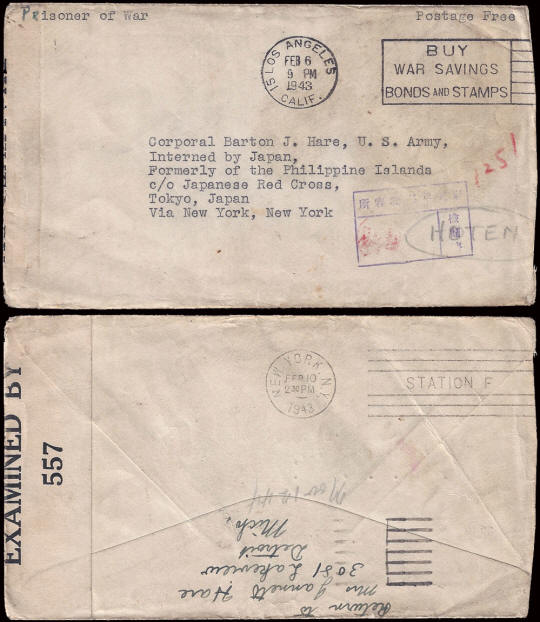 |
|||||
|
This is a cover sent by the soldiers mother in Detroit, she was only aware of the last area in which her son Corporal Hare had seen service prior to capture. He was with Battery "B" 60th Coast Artillery (Anti-Aircraft) which surrendered to the Japanese on 6th May 1942 on Corregidor. His unit had been tasked with the defence of the bays of Subric and Manila in the Philippines. A relation, Ron Govenlock contacted me having seen this page on the internet, he told me that Barton J Hare was born on Jan. 29, 1917 in St Louise, he joined the US Army on Nov. 12, 1935 and received his release on May 5, 1946. He died Sept. 9, 1972 in Frankfort, Indiana. The postage date is 6ft February 1943 indicated by the Los Angeles machine postmark with the slogan "BUY WAR SAVINGS BONDS AND STAMPS". This date may indicate that he was among the first intake of prisoners arriving in November 1942. He would have left the Philippines on the Tottori Maru on 8th October 1942 and arrived in Manchuria via Japan and Korea. From Los Angeles the cover travelled to New York where it was censored and then presumably passed to the Red Cross. The cover has the violet censor box as seen above with a red hanko (seal), probably that of Lt. Murata. There is the camp name "HOTEN" circled in pencil this was used to forward the mail to the correct camp. The orange 1251 is almost certainly the prisoner number, much of the mail is numbered in this way. Pencil markings on the back of the envelope seem to indicate that he received the letter on 12th November 1944, this is consistent with the background information at the top of this page. |
|||||
| PFC William Adrian Diemert - U.S. Marine Corps. (1921 - 1997) | |||||
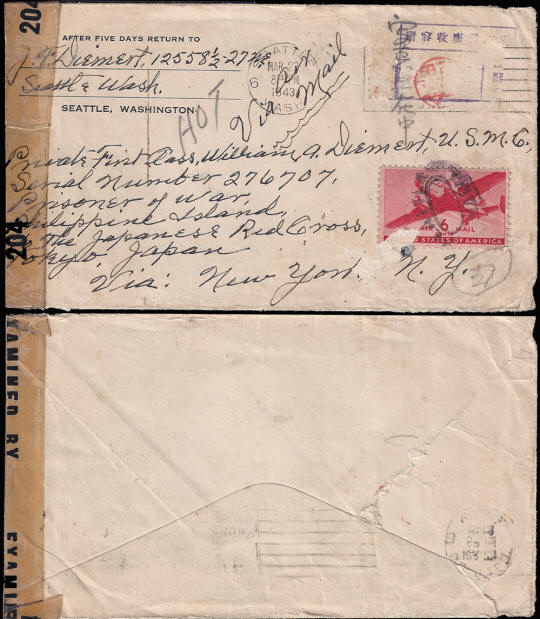 |
|||||
|
PFC Diemert arrived at Mukden POW Camp
in 1942 having been transported on the Tottori Maru. This letter was
sent to him by his Father on 22nd March 1943 as shown by the
date-stamp. The letter was censored twice, once on its outward journey from the U.S.A. when it was re-sealed with censor tape, and when it reached Mukden as shown by the violet censor hand-stamp containing the hanko of Lt. Murata. The cover would have been sent to the Japanese Red Cross where it would have been sorted and "HOT" short for Hoten was added in pencil. This cover appears as an example in A Postal History of the Prisoners of War and Civilian Internees in East Asia During the Second World War, Volume 6 - Hellships to Slavery by David Tett FRPSL |
|||||
|
|
|||||
| Cpl. John Norman Anderson U.S. Army 194th Tank Corps (1918-1989) | |||||
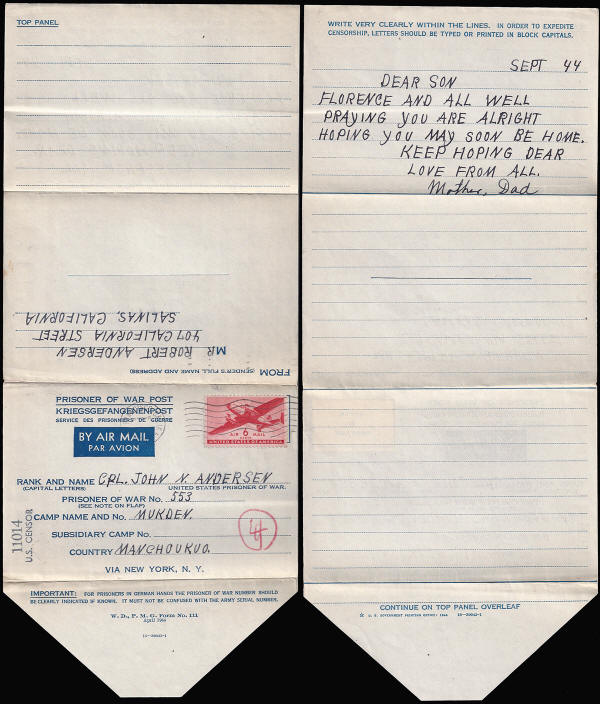 |
|||||
|
CPL Anderson arrived at Mukden POW Camp
on 11th November 1942 he had endured the Baatan death march and
transportation on the notorious "Hell Ship"
Tottori Maru.
By September 1944 when the above letter sheet entered the postal system it is clear that the family of Cpl. Anderson knew he had been transferred from Cabanatuan camp in the Philippines to Mukden. They also knew he had been assigned the prisoner number 553 and wrote to him regularly as several similar examples are known. The probability is that he was unaware of all this mail until shortly before his liberation. Postal markings include a San Francisco postmark dated September 1928 and a US Censor hand-stamp. The red pencil circle contains a "H" indicating Hoten POW Camp. It is likely that this letter not reach Cpl Andersen until the camp was surrendered. After more than 80 years this item is still in perfect condition. |
|||||
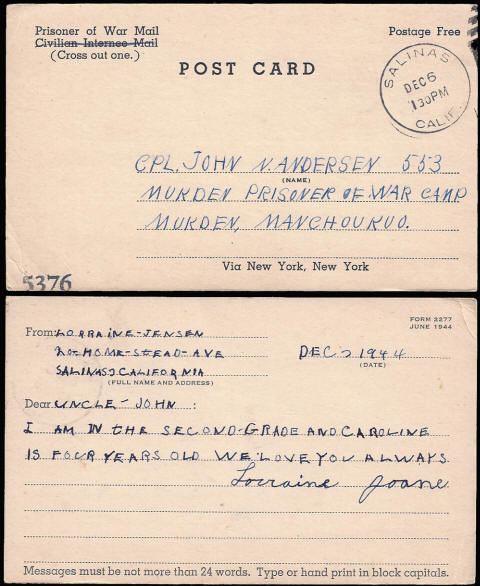 |
|||||
|
This cad shows a US postmark for Salinas, California dated 6 December 1944, also present is a US censor number 5376. There are no Japanese forwarding or censor markings on this cover and this would indicate that Cpl. Andersen received the card after the camp was liberated. It is possible that it was still in transit when the war ended. All of the young volunteers from Salinas at that time were put into the same unit. They were in the 194th tank regiment, a National Guard unit. They were sent to the Philippines to delay the Japanese army until the U.S.A. could get enough regular troops to send into the area. The story of the the 194th Tank Corps can be found here (pdf file). Anderson survived the war and was evacuated from Mukden by train on 10th September 1945. |
|||||
|
|
|||||
|
OUTGOING MAIL Outgoing mail from Mukden is hard to find, particularly from non-American prisoners, these items always achieve high auction prices. Even American P.O.W. covers from Mukden are rare as so little mail was sent from the camp. |
|||||
| Trooper George Sydney Foley - British 18th Battalion Recon Corps. (1915 - 1991) | |||||
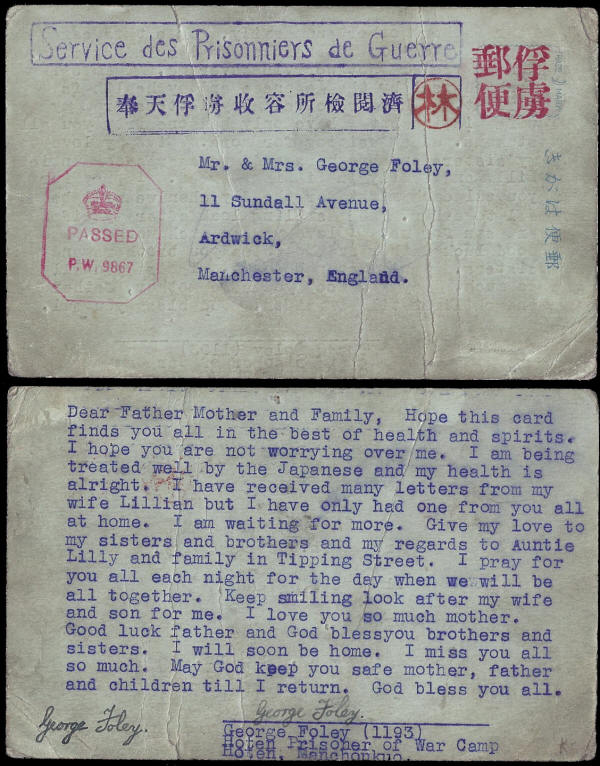 |
|||||
|
George Sydney Foley arrived at Mukden in
1942, having become a P.O.W. when Singapore surrendered to the
Japanese on 15th February 1942. His camp P.O.W. number was 1193 and
this appears in brackets at the
The postal markings are those you would expect to see on cards from Mukden. The purple boxed cachet "Service des Prisonniers de Guerrre" the purple 奉天俘虜収容所検閲濟 Mukden P.O.W. Camp Censored. The red circular censor's mark 林 is the seal of the censor Hayashi. The four red characters in place of a stamp read 郵便俘虜 Furyo Yǔbin Prisoner of War Post . Last we have the red octagonal British censors hand-stamp containing the crown of King George V, PASSED and the censor number P.W.9867. (This item was once part of the Robert W. Farquhar collection). |
|||||
|
|
|||||
| Unused Hoten Camp Prisoner Postcard | |||||
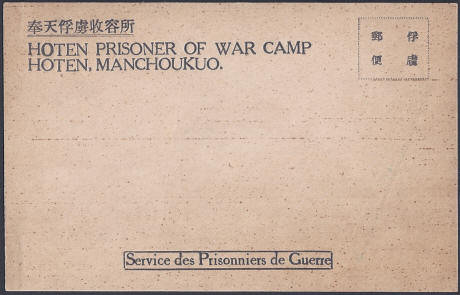 |
|||||
|
This card comes from a group of
mementoes brought home by Lt Col Earl Tracey. Halstead (US Army
Luzon Force
AG) a prisoner at Hoten POW camp.
He arrived at the camp in May 1945. This is one of five cards he is
known to have liberated and as such is a rare survivor. The reverse
of the card is blank. The four characters in the box reserved for a stamp read 郵便俘虜 Furyo Yǔbin Prisoner of War Post, a stamp was not normally needed as post was censored then forwarded to the Red Cross for distribution.
Leaflets These leaflets were dropped on POW Camps in China towards the end of the war to give instructions to POW's on what to do when the war ended, and to let them know the Japanese had surrendered. They are rare survivors. |
|||||
|
|
|||||
| Web Resources | |||||
Mukden Prisoner Of War Remembrance Society This site preserves the memory of the prisoners and documents the history of the Mukden camps. All prisoners are listed complete with units, ranks, serial numbers and POW numbers (where possible). The Society maintains contact with the "Hoten" POW camp museum in Shenyang and supports the travel to China of ex-POWs and other interested parties.Center for Research - Allied POWS Under the Japanese This website is also dedicated to preserving the memory of POWs and has a useful timeline which I found very helpful in my research. It also has full details of the evacuation of the camps in Mukden. |
|||||
|
Hoten POW Camp Liberated Newsreel footage of the liberation on Youtube. This video shows the prisoners and the men sent to take them home. There are pictures of the main camp and the aircraft sent to rescue the infirm and high ranking prisoners. The rest of the men look thin and reasonably fit, it is now the Japanese that are the POWs. |
|||||
| Further information is to be found on the internet but the above three are the most useful to any researcher. | |||||
|
|
|||||
| Books | |||||
|
The Postal History of the Prisoners of War and Civilian Internees In East Asia During the Second World War. Volume 6, Japan, Korea, Manchuria and Borneo 1942-1945, Hellships to Slavery by David Tett F.R.P.S.L. Publihed by BFA Publishing. |
|||||
|
Guests of the Emperor The Secret History of Japan's Mukden POW Camp by Linda Goetz Holmes, published by Naval Institute Press |
|||||
|
The Hard Way Home From Corregidor to Manchuria, three years as a prisoner of the Japanese in World War II, by William C. Braly Published by the author. |
|||||
|
|
|||||
|
|
|||||

